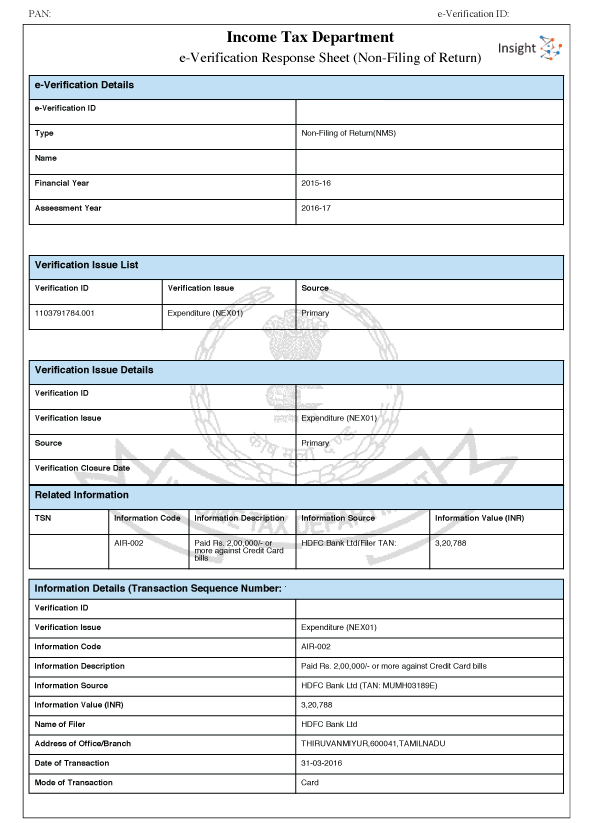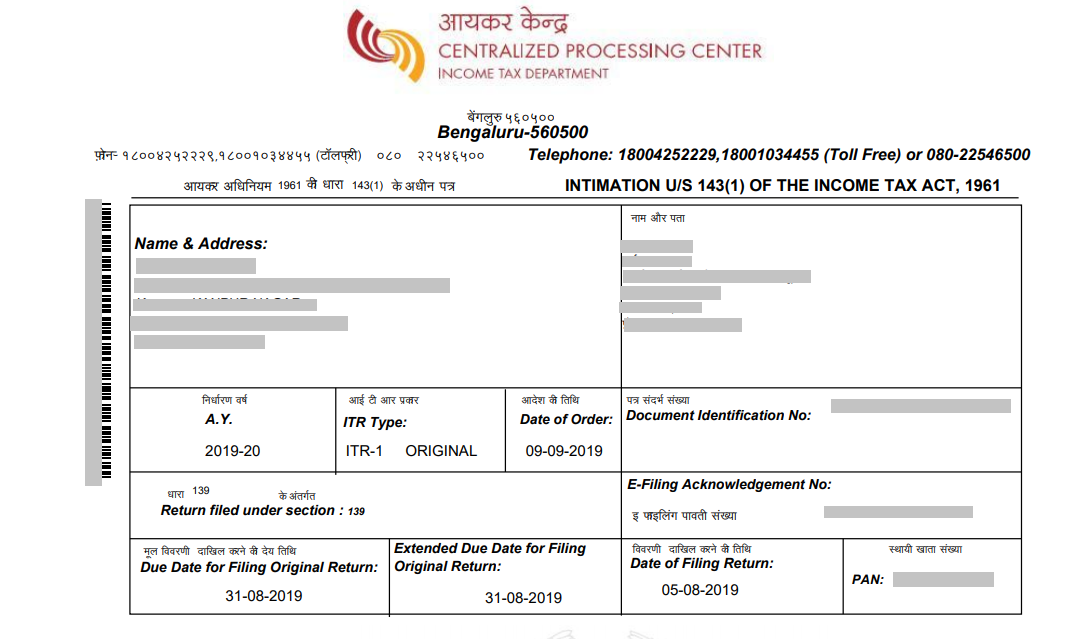What is an Income Tax Notice?
Did you receive an Income Tax notice and are wondering how to respond to it? Or maybe you are wondering what an income tax notice is? Or perhaps you want to know when is an income tax notice is issued? Don’t worry we got you covered. Read on to find answers to the above questions and know what you should do after getting an IT notice.
Table of Contents :
- What Does an Income Tax Notice Look Like
- Why Did I Get an Income Tax Notice
- Types of Income Tax Notice- Understanding the Cause and the Consequences
- Notice under Section 142(1)
- Intimation under Section 143(1)
- Notice under Section 143(2)
- Notice under Section 148
- Notice under Section 245
- Notice under Section 139(9)
- Notice under Section 131(1A)
- Notice under Section 156
- What to Do When you Receive an Income Tax Notice
What Does an Income Tax Notice Look Like
Following is a sample image of an online Income Tax Notice issued for ‘Non-Filing of Return’.


Get FREE Credit Report from Multiple Credit Bureaus Check Now
Sample Income Tax Notice of Intimation u/s 143(1)
Following is an illustrative example of an income tax notice of ‘intimation sent under section 143(1) of the Income Tax Act’.
 What is an Income Tax Notice
What is an Income Tax Notice
Income tax notice is a legal document using which the Income Tax Department communicates with the taxpayers. It can be just an intimation or a demand for further information, tax payment, etc. Getting an income tax notice does not always indicate trouble for the receiver. It can also be issued to provide details regarding the refund any excess tax paid by you or to request submission of some additional documents. Thus, it is important to understand why an income tax notice has been issued in the first place.
Read more: Income Tax in India – Tax Guide, Types & ITR Filing
Why Did I Get an Income Tax Notice
Income tax notices can be issued for various reasons under different sections of the Income Tax Act. Following is a short list of the major reasons you might receive an income tax notice:
- Not filing ITR at all
- Delay in ITR filing
- Defective ITR filing
- Not disclosing all the sources of income in your ITR
- Outstanding tax, interest, penalty or fees payable to the IT Department
- When your ITR is selected for scrutiny
- When you tax refund is used to set off any outstanding tax payments
- When there is a discrepancy in the amount of losses claimed by you at the time of ITR filing
Types of Income Tax Notice- Understanding the Cause and the Consequences
Notice under Section 142(1)
An Income Tax Notice under 142(1) section is issued in the following cases:
- For enquiry before an assessment: A notice can be issued when you have filed your ITR, but the Assessing Officer requires you to provide additional information and documents.
- For delay in filing ITR: The due date for ITR filing is generally 31st July of the relevant assessment year (AY). However, if you have not filed ITR by the due date, you will get a reminder notice from the Income Tax Department. Such a notice is issued before the end of the applicable assessment year.
Consequences
Missing the ITR filing deadline can lead to the following penalties:
| Late ITR filing fee as per Section 234F (for FY 2022-23) | ||
| ITR filing date | Total annual income (Rs.) | |
| Below 5 lakh | Above 5 lakh | |
| On or before due date (officially 31st July) | NIL | NIL |
| After due date 31st December 2023 | Rs. 1,000 | Rs. 5,000 |
| From 1st January to 31st March 2024 | Rs. 1,000 | Rs. 10,000 |
- Moreover, simple interest at the rate of 1% is charged over the unpaid tax from the due date to the date of delayed ITR filing.
- Jail term may be applicable in addition to penalties, if someone fails to file ITR altogether. The term can vary from 3 months to 2 years. It should be noted that this is an extreme step, which is only taken when the ITR is not filed in the relevant AY even after multiple tax notices.
Read more about late ITR filing penalties

Get FREE Credit Report from Multiple Credit Bureaus Check Now
Intimation under Section 143(1)
Intimation under section 143(1) is issued in the following 3 cases:
- Tax Demand: If the Income Tax Department finds any tax liability after processing your ITR, you are issued a tax demand notice to deposit the due tax within a certain time limit. Failing to adhere with the specified time limit can result in various penalties.
- Tax Refund: Such a notice is issued when you have paid taxes in excess of your actual tax liability. This notice is to inform you about the refund of excess tax by the IT Department. In this case, you are advised to check the Income Tax Refund status.
- There is no demand or refund, but there is some calculation mismatch in the amount of loss.
Notice under Section 143(2)
This notice is sent by the Income Tax Department when the ITR filed by you is randomly picked for scrutiny to check for tax compliance. The department checks for the following:
- Understatement of income
- Excess claims for losses
- Underpayment of income tax
This notice is issued within 6 months of completion of the assessment year to which the notice pertains. Further, applicable penalties can be instituted after the scrutiny.
Notice under Section 148
This notice is issued when any income has escaped assessment. In other words, this notice is issued when according to the Assessing Officer you did not correctly disclose your income, and thus paid lower taxes. In this case, the Assessing Officer generally recomputes/reassesses the ITR. If any discrepancy is found after the reassessment, relevant penalties will be applicable.
Notice under Section 245
This notice is issued when a tax refund payable to a taxpayer by the Income Tax Department is used to set off any previous tax dues. Hence, if you have pending tax liability as well as a tax refund, then you will not be credited the refund amount. Rather the refund shall be used to adjust the dues. Such an adjustment is made after a written intimation of the proposed action to the taxpayer under this section.
Notice under Section 139(9)
This notice is issued in case of a defective return. Under this section, the assessee has an opportunity to rectify the defect within 15 days from the date of intimation. If the assessee fails to rectify the defect within the specified time period, the filed return will be considered invalid. Hence, failing to rectify the defective return within 15 days of intimation will be treated as the same as not filing ITR at all.
Note: If the assessee rectifies the defect after the expiry of the said period of 15 days, but before the assessment is made, the Assessing Officer may condone the delay and treat the return as a valid return.
Notice under Section 131(1A)
This notice is issued when the income is either concealed or likely to be concealed. It is to inform that the Assessing Officer has initiated an enquiry and may ask the assessee to produce the books of account and other related documents.
The Assessing Office under this section has the following powers:
- To conduct inspection
- To examine the relevant persons under oath
- To compel the production of relevant documents
- To issue commissions

Get FREE Credit Report from Multiple Credit Bureaus Check Now
Notice under Section 156
An income tax notice under this section refers to the ‘Notice of Demand’. It is issued when the assessee has outstanding tax, interest, penalty, fine or any other outstanding sum payable to the Income Tax Department. Such an outstanding payment has to be made by the assessee within the specified time to avoid any penalties.
How Do I Respond to an Income Tax Notice
Stay calm and carefully verify the details. Understand the cause for the issuance of the notice and take the necessary steps. Please note that you should never ignore an IT notice. If you are not sure of handling the matter by yourself, take help from a chartered accountant or a tax expert.
Furthermore, take a note of the following points to avoid any legal consequences:
- Respond to the notice with all the necessary information and documents within the stipulated time. If the complete documents are not available, you can request for some time but do send what is already available.
- Communicate with the IT department, if there is any delay in sending the paperwork. This will not only keep them in the loop but also show that you intend to comply with the requirements of the assessing officer.
- Sometimes for random scrutiny, the document list is not specified by the department. In such a case, you must collect all documents which will support your answer and submit them.
- When all the documents and information are ready, write a cover letter giving an outline of your response. In this letter, try and address all the queries raised and also provide a complete list of documents you are sending along with your response.
- Keep a copy of the documents that you are sending. This is for your records if another query is raised after you submit the initial response.
- When submitting a reply, you must try and take an acknowledgment from the department stating that they have received the information. This will act as proof, if there is any dispute at a later date.